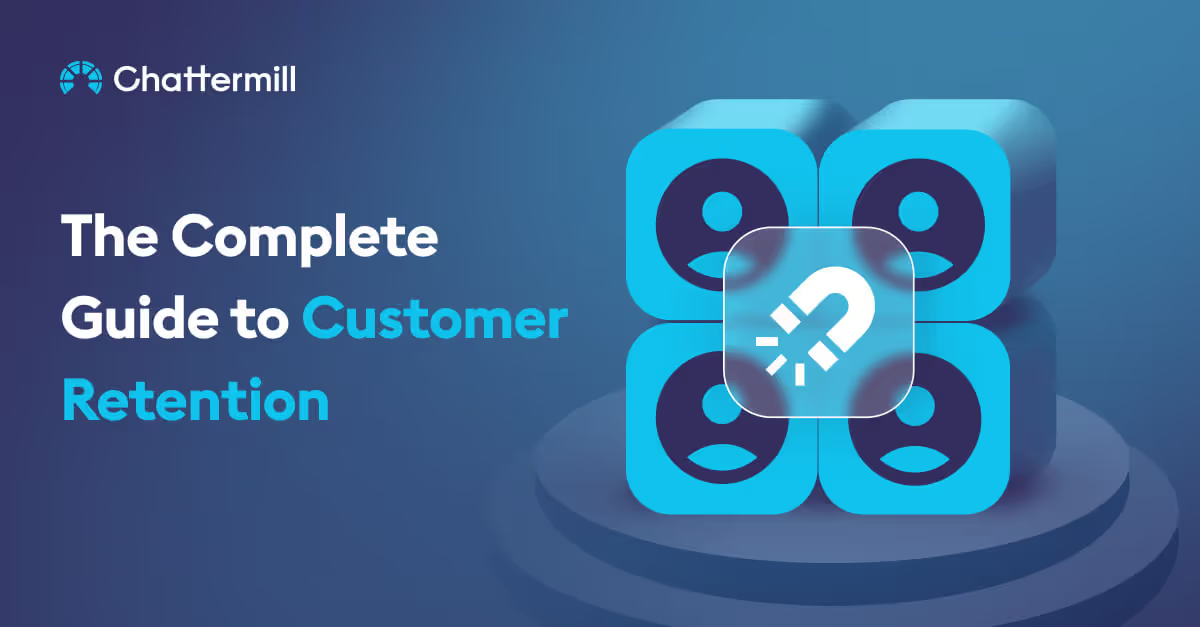Customer retention relies on the conception of value, which is incredibly difficult to measure as it’s subjective. Complicating things further, a good customer retention rate isn’t the same from industry to industry and business to business.
In a subscription service, customers automatically opt into buying every month. It’s an upfront statement of loyalty to your brand, even for a period of time. Retention then, might be how long a customer holds their subscription. Or, it could be the number of customers that pause their subscription and return within a set period of time vs customers that never return.
For other retailers, a single purchase might last the customer a year or more. Does retention then count as those who return after a year or more?
Companies must first determine what customer retention is for their company, then weigh a customer’s lifetime value and determine whether retention is a worthwhile investment.
What is the value of customer retention to a business?
The customer experience is the entirety of an individual’s experience with a brand. It’s the product itself, the email correspondence, the support…. So, as a consequence, it’s not static. It can change over time, because a customers’ experience with the brand might change over time.
One customer might buy every six months, and that would be a sufficient level of retention. If you’re a mortgage company, repeat purchases might not be so important. If you’re a subscription business, it’s your absolute bread and butter.
But let’s say the customer buys a product from the same company every week. There’s likelihood they’ll share their love for the brand with others. There’s a positive word of mouth side of things.
So, for whatever length of time the customer uses the product, there’s a benefit to the brand, regardless of how frequently they purchase. Ongoing loyalty is less tangible, and pretty hard to measure, but there’s an intense value as well.
Connor Abene, a Fractional CFO, emphasises the value of customer retention:
“It's crazy what small changes in customer retention can do for a business. This is one area I highly emphasise for all my clients. Improving customer retention is one of the highest leverage activities you can do.”
The explicit value of customer retention may depend on your business, but it’s pretty clear that retention should be a top priority for any brand. But there are other benefits to customer retention that are of note…
Why Customer Retention is So Important for ROI, Customer Loyalty, and Growth
Extends the customer lifetime value for your business
If you’ve built a feedback loop, and consistently listen to your customers and what they want, you’re able to adjust your product, and find upsell and cross sell opportunities. This inherently extends the lifetime value of your customer base.
You continue to provide more of what they want, and they’ll want to keep buying.
Improves customer satisfaction
Naturally, if you’re fixing all of the issues your customers tell you about, they’ll see that they have value in your eyes. They aren’t just another number to you.
Putting effort into customer retention impacts customer satisfaction, and vice versa. It’s cyclical. You may even think of the two as predictors of each other. The better they feel about their interactions, the more likely they’ll stay. The more likely they are to stay, the more likely they’re satisfied.
If you’re focusing on actions that retain customers and build those positive feelings about your brand, you’ll drive future positive behaviours (such as word of mouth marketing).
Creates more opportunities for customer feedback
“Good product teams don't build features that they think users want. They validate their decisions with research,” says Liam Moroney, Co-Founder of Storybook Marketing.
If you’re listening to your customers, you may slow down product development, but you make decisions based on what customers want rather than making potentially poor assumptions.
A solid focus on customer retention matures processes such as feedback loops, and ensures you’re always open for more customer insights.
Decrease customer churn rate
Customer churn is not just a customer experience problem. It’s a business problem. Customer experience work towards ensuring satisfaction and referrals, they collect insights about your customers, and free up account executives. But they cannot prevent all of a business’ customer churn.
By focusing on the right customers, improving your product, operations, and experience per customer requests, and focusing on upselling and cross selling to existing customers (as well as engaging them), you decrease customer churn.
Customer retention vs. customer acquisition
When businesses lose customers, they often think they’ll replace those customers with new ones. So the business spends more money trying to acquire those new customers rather than focus on their existing base.
According to Deborah Myers, CEO of VirtuArt, “What they don't think about is the lost sales in future years from that customer and referrals that customer could have made. This mindset will also reflect in how customers feel they are being treated by the company. Businesses fixated on acquiring new customers, get the sale and then move on. Leaving customers to feel like a transaction or a number, but a person.”
Don’t get us wrong, customer acquisition is an important focus for any business. But without customer retention, you’re simply telling your customers they don’t matter. That they’re replaceable.
Still, there are potentially some benefits to customer acquisition over retention:
- If you’re a new business, you may still be working on growth and narrowing your ideal customer.
- Acquisition is a short term game with quick wins, and this can be favorable if you’re trying to show rapid growth.
But as said, most businesses, across almost every industry fair better with a balance of focus on acquisition and customer retention.
The benefits of customer retention include:
- More revenue per customer, as well as an extension of the customer lifetime value.
- Boost in referrals and promotion from existing customers, which may reduce your customer acquisition costs (and efforts).
- You’ll continue to grow your business, though more sustainably.
- A stronger base of insights about your customers, which helps you improve your products, support, and operations even further.
In either case, it pays to put much of your attention into consistently improving your experience and tailoring it to your customers’ expectations, needs, and wants.
How to Improve Customer Loyalty and Retention
Why do customers leave companies?
In CX, customer feedback is essential to guiding and informing decision making about our products and services. It allows us to truly understand our customers. Yet, there are still companies that don’t collect feedback seemingly at all, and it truly shows.
Take Netflix, for example. They appear not to ask their customers for feedback. Of course, they could have their own methods of collecting customer data, but direct feedback is a missing and crucial source of intelligence that’d enable them to solve their retention issue.
While Netflix’s competitors boom and steadily make “Netflix and chill” a potential thing of the past (though they have recently made some improvements), they’re not alone for the sinking ride.
There are far too many companies not learning from the mistakes of Netflix and companies like them. Instead they seem to accept churn, and like Deborah Myers stated, believe they can simply replace them.
It is that blunder – the feeling of mistreatment or disregard by a company – that causes many customers to leave.
Of course, it isn’t the only reason. Other reasons for customer churn include:
The customer may have…
- Left the market
- Found a more competitive price that suits their budget
- Poor customer experience
- Product didn’t live up to expectations
- Shipping issues
- Poor UX
- Poor communication with your customers
- Product changes they didn’t like
- There’s no reward for their loyalty
And a multitude of other reasons.
Customer experience seems to be one of the largest reasons customers don’t remain loyal. After only two to three bad CX experiences, 86% of customers will leave a brand, even if they were loyal to them.
Still, you can only determine exactly why customers leave by collecting and analysing feedback. Ideally, you’d send a feedback survey at time of first purchase and then at the point of churn. Comparing this data will help you understand both why customers stay with you and why they ultimately leave for your competitor.
Customer Retention Metrics & How to Measure Them
Why Unified Customer Intelligence is key to customer retention
Of course, customer feedback aren’t the only data points we should collect and listen to. You need a complete view of all data points – surveys, app reviews, chatbots, conversations with customer support, on-site behaviour, and more – to understand what drives both churn and retention.
Unify all of your customer data points, from all of your sources, in a centralised database to gain full visibility. Placing them side by side, you’ll get the full picture on your customers’ reality, issues driving customers to leave for competitors, and feedback that’ll help you build loyalty and retention for your brand.
Find out more about Unified Customer Intelligence
Book a Unified Customer Intelligence Demo
Customer Retention: FAQs
What is customer retention?
Customer retention is the ability of a business to keep its existing customers engaged and returning over time. It reflects how well a company builds long-term relationships and delivers ongoing value.
Why is customer retention important?
Retention drives sustainable growth by reducing churn, increasing lifetime value, and lowering the cost of acquiring new customers. Loyal customers also generate referrals and positive word of mouth.
How is customer retention measured?
Retention is measured using metrics such as retention rate, churn rate, customer lifetime value (CLV), repeat purchase rate, and Net Promoter Score (NPS).
What factors influence customer retention?
Key factors include product or service quality, pricing, customer support, personalization, and the overall customer experience across touchpoints.
How can businesses improve customer retention?
Effective strategies include loyalty programs, personalized communication, proactive customer service, acting on feedback, and consistently meeting or exceeding customer expectations.
What industries benefit most from customer retention strategies?
Industries such as SaaS, e-commerce, financial services, hospitality, and subscription businesses rely heavily on retention, but all sectors gain from keeping customers engaged.
What is the difference between customer retention and customer acquisition?
Customer retention focuses on maintaining relationships with existing customers, while customer acquisition is about attracting new ones. Both are essential, but retention is often more cost-effective.
How does customer retention impact profitability?
Retained customers are more likely to make repeat purchases, spend more over time, and require fewer marketing costs—leading to higher profitability and long-term growth.















